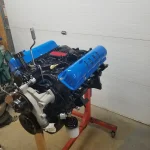I'm quite well versed in Ford FEs. I own one. And have been inside it.
My point was that 40 years ago, we were not able to make mass produced OHC engines. Obviously the SOHC Ford 427 isn't a mass produced engine. Legendary? ABSOLUTELY! But not mass produced. It produced so much HP that the metallurgy wasn't up to the task in the 60s for bottom ends.
All my 80s VAG SOHC and DOHC engines would easily go 300K miles with only timing belts, water pumps, and oil changes.
We are talking 40 years ago, no American OHC engine could do that.
Ford had had Mazda help, on the 4 and 6 cyl, and has done well.
Not jabbing anyone, just stating my experience as a long time mechanic and antique car enthusiast.
The Duratec 8V was a Kent engine, had no Mazda help. Its lineage is from Ford's European operations. There were many others in the Duratec family that didn't have Mazda DNA in them.
The Ford Kent family has a pretty storied history, being used by Cosworth and there being several OHC iterations.
The Duratec V6 isn't 40 years ago, as it appeared in the 90's, but also did not have any Mazda involvement.
You are using the royal "we" here, but GM and Ford are multinational corporations with operations on multiple continents, ergo, Ford Europe is still Ford

As is Ford Australia, who, starting in 1988, produced an SOHC version of the Ford i6 for the Falcon, which definitely slots-in under mass produced.
Ford not introducing some of their OHC offerings from their various other operations into North America doesn't preclude them from being able to produce them, that was my point in calling out the earlier experiences with it from back in the 1960's. They preferred to produce pushrod engines for the North American market prior to the introduction of the Modular, likely because that's what sold. There are motives for choices made that aren't driven by incompetence, which appears to be the implication being made, that Ford, GM and Chrysler were incapable of producing OHC engines, but this is in spite of the fact that they were doing exactly that elsewhere, and getting good service out of them.
Edit:
And of course the Modular development started in the mid 80's with formal introduction happening in 1990, so I'd argue it slots in there too, and we know how good of an engine family (other than the 3V) that ended up being.
The competence and capability were there, but the motivation to do so wasn't. That should be the discussion, IMHO. Why did it take until the mid 80's for Ford, for example, to garner an interest in producing an OHC engine for domestic consumption? I think the answer lies in the type of vehicles that were the bread and butter for these companies, which, at the time, were large cars and trucks.

